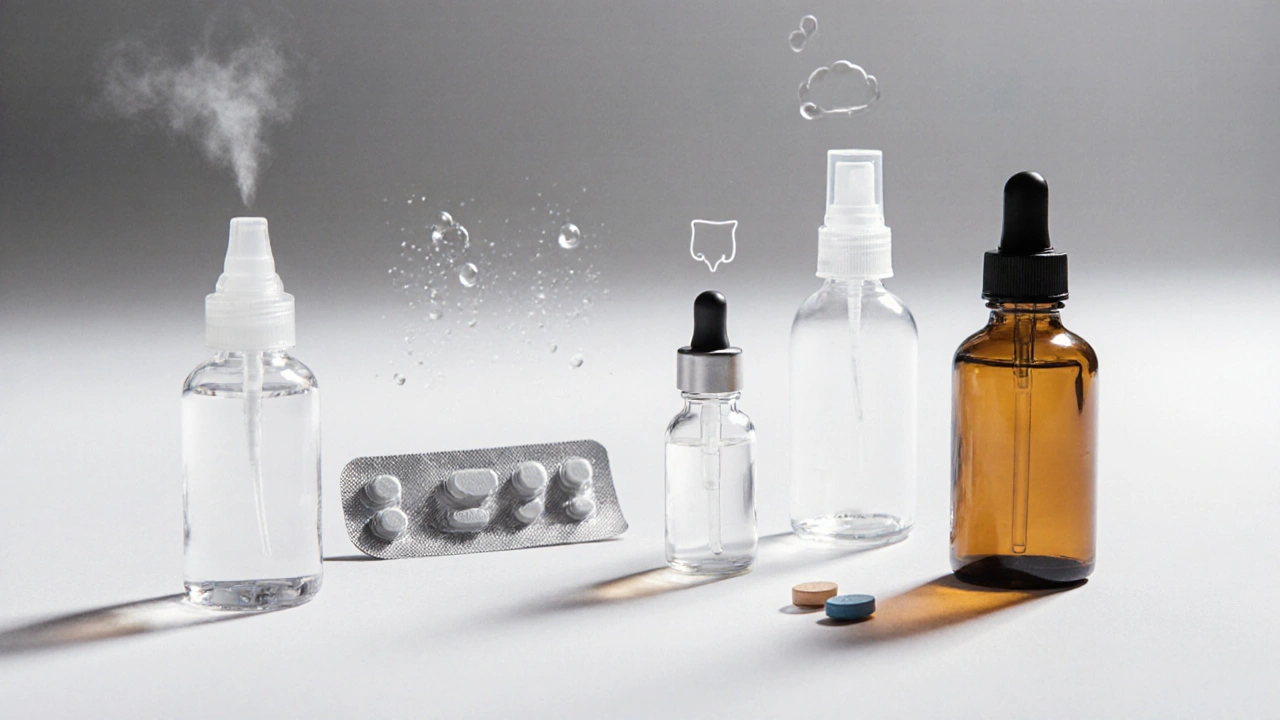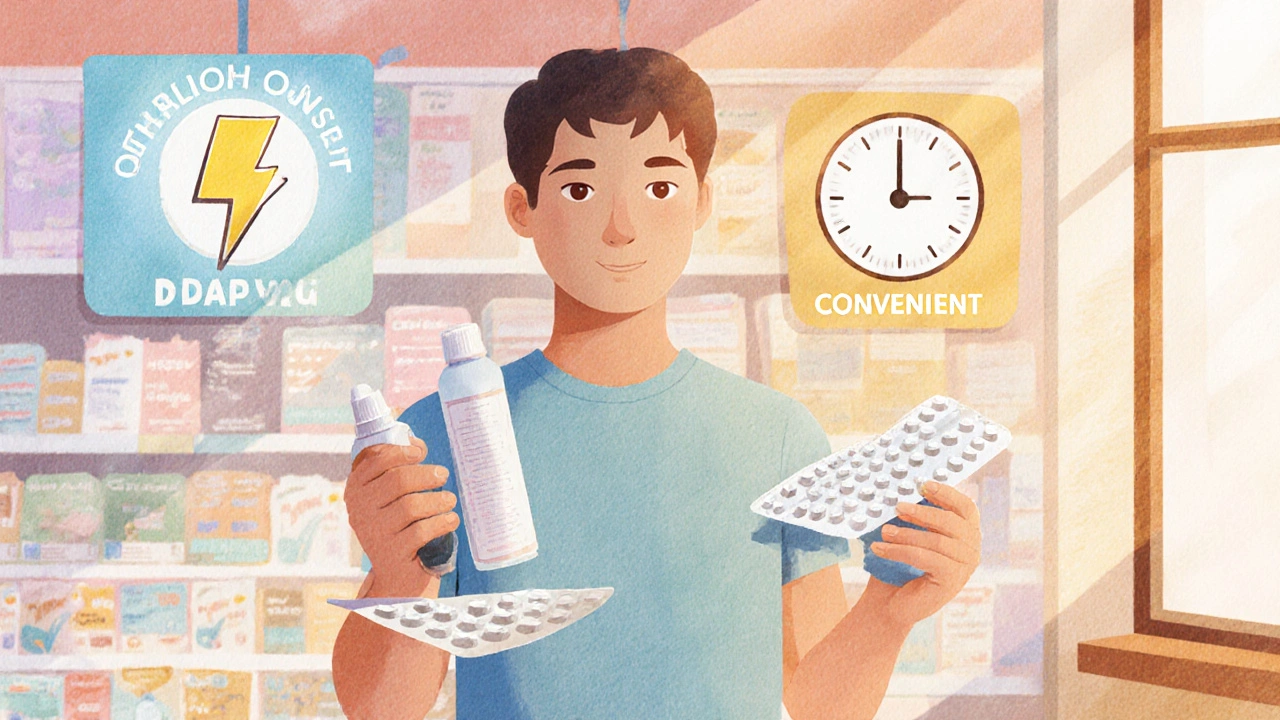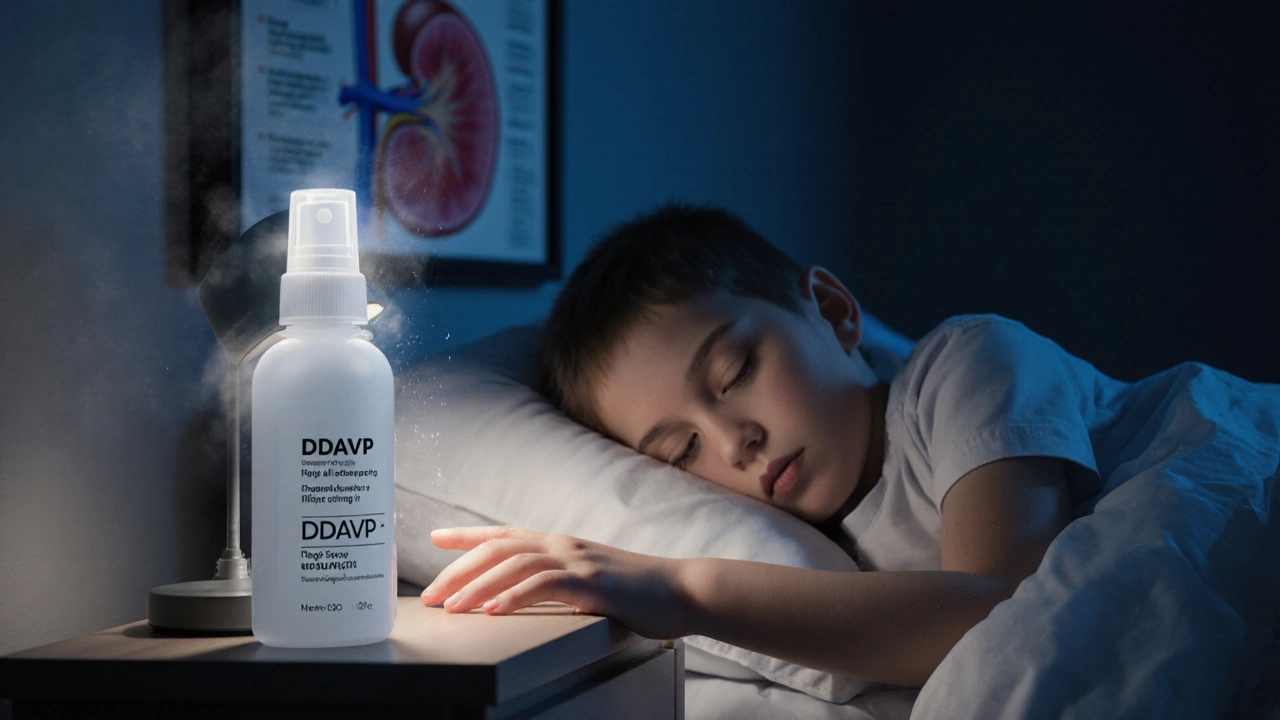DDAVP Spray vs Alternatives Comparison Tool
Ever wondered if the nasal spray you’re using for diabetes insipidus or bedwetting is the best option? DDAVP spray is a popular choice, but a handful of other meds can do the job-some better, some worse-depending on your condition, lifestyle, and budget. This guide breaks down DDAVP spray, shows you the most common alternatives, and gives you a clear side‑by‑side comparison so you can pick the right formulation for you.
- DDAVP spray delivers desmopressin acetate as a nasal mist, offering rapid absorption.
- Oral desmopressin tablets are convenient but have slower onset.
- Vasopressin nasal spray is an older hormone with a different safety profile.
- Tranexamic acid and anticholinergics are non‑hormonal options for bleeding disorders and nocturnal enuresis.
- Choosing the right product depends on condition, dosing frequency, side‑effects, and cost.
What is DDAVP Spray?
When treating conditions like central diabetes insipidus, DDAVP spray is a synthetic analog of antidiuretic hormone (ADH) delivered as a nasal spray. It contains desmopressin acetate and has been on the market since the early 1970s. The spray form bypasses the digestive system, giving faster blood levels compared with tablets.
How DDAVP Spray Works
Desmopressin binds to V2 receptors in the kidney collecting ducts, signaling the insertion of aquaporin‑2 water channels. The result is less urine output and more concentrated urine. Because the nasal mucosa is highly vascular, the spray reaches peak plasma concentrations in 30‑45 minutes, making it ideal for patients who need quick control of nocturnal polyuria or rapid correction of a DI episode.
When Doctors Prescribe DDAVP Spray
- Central diabetes insipidus (CDI): patients lack natural ADH, so a replacement is required.
- Nocturnal enuresis (bedwetting) in children and adults: the spray reduces nighttime urine production.
- Bleeding disorders (mild hemophilia A, von Willebrand disease): desmopressin raises factor VIII and vWF levels temporarily.
Dosage varies widely-typical pediatric dosing for enuresis is 0.2µg/kg once nightly, while adult CDI dosing starts at 10-20µg (0.1-0.2mg) per day, split into one or two sprays.
Common Alternatives to DDAVP Spray
Not everyone tolerates a nasal spray, and some insurance plans favor oral pills. Below are the most frequently considered substitutes.
Desmopressin tablets (often marketed as Minirin) are the oral counterpart. They contain the same active ingredient but must survive stomach acid, leading to a slower onset (1-2hours) and a slightly lower bioavailability (≈15‑20% vs 30‑40% for the spray).
Vasopressin nasal spray is an older formulation of the natural hormone. It has a broader receptor profile, which can cause more cardiovascular side‑effects (e.g., hypertension). It’s rarely used now for CDI but may appear in emergency kits for bleeding control.
Tranexamic acid (TXA) is an antifibrinolytic used to prevent excessive bleeding in hemophilia and surgical settings. It does not affect urine output, so it’s irrelevant for DI or bedwetting, but it’s a non‑hormonal alternative for patients who can’t use desmopressin.
Anticholinergic medications (e.g., oxybutynin, tolterodine) reduce bladder overactivity, helping nocturnal enuresis without altering ADH levels. Side‑effects include dry mouth, constipation, and occasional cognitive fog, especially in older adults.
Side‑Effect Profiles at a Glance
- DDAVP spray: nasal irritation, hyponatremia (if fluid intake isn’t limited), headache.
- Desmopressin tablets: similar hyponatremia risk, gastrointestinal upset, less nasal discomfort.
- Vasopressin spray: possible hypertension, abdominal cramps, nasal irritation.
- Tranexamic acid: nausea, GI upset, rare thrombotic events.
- Anticholinergics: dry mouth, constipation, blurred vision.

Side‑by‑Side Comparison Table
| Form | Typical Dose | Onset | Duration | Main Use | Pros | Cons |
|---|---|---|---|---|---|---|
| Nasally administered DDAVP spray | 10‑20µg (1‑2 sprays) daily | 30‑45min | 6‑12hrs | CDI, nocturnal enuresis, bleeding disorders | Fast onset, avoids GI tract, lower dose needed | Nasal irritation, hyponatremia risk |
| Oral desmopressin tablets | 0.1‑0.4mg once daily | 1‑2hrs | 12‑24hrs | CDI, enuresis, mild hemophilia | Easy administration, no nasal side‑effects | Slower onset, higher dose needed, GI upset |
| Vasopressin nasal spray | 5‑10IU per dose | 15‑30min | 4‑8hrs | Emergency bleeding control, rare CDI use | Very rapid action, strong vasoconstriction useful in emergencies | Hypertension, cardiovascular strain, nasal irritation |
| Tranexamic acid oral | 1‑1.5g 2‑3×/day | 30‑60min | 6‑8hrs | Bleeding prophylaxis (surgery, trauma) | No effect on urine output, cheap, well‑studied | Thrombotic risk, GI upset |
| Anticholinergic (oxybutynin) | 5‑10mg at bedtime | 1‑2hrs | 12‑24hrs | Nocturnal enuresis, overactive bladder | Reduces bladder contractions, works when ADH pathways fail | Dry mouth, constipation, possible cognitive effects |
How to Choose the Right Option for You
Think of the decision like picking a vehicle: you need to match the terrain (your condition), fuel efficiency (dose frequency), and comfort (side‑effects).
- Assess the primary goal. If you need rapid control of polyuria (e.g., night‑time CDI spikes), the spray’s quick onset is a clear advantage.
- Consider adherence. Kids who dislike the “spritz” may prefer a tablet tucked into breakfast. Adults who travel frequently might favor a discreet pill.
- Check the safety profile. Hyponatremia is the biggest red flag for any desmopressin product. If you have a history of low sodium or are on high‑fluid diets, a non‑hormonal option like tranexamic acid (for bleeding) or anticholinergics (for enuresis) could be safer.
- Look at cost and insurance coverage. In the U.S, generic oral desmopressin tablets often cost less than the branded nasal spray. Some plans consider TXA a Tier‑1 drug, making it the cheapest for surgery‑related bleeding.
- Think about comorbidities. Patients with uncontrolled hypertension should avoid vasopressin spray. Those with chronic constipation may steer clear of anticholinergics.
In practice, many clinicians start with the spray for acute control, then transition to tablets for long‑term maintenance once the dose is stable.
Practical Tips for Switching Between Forms
- Start low, go slow. When moving from spray to tablets, reduce the total daily dose by about 30% and monitor urine output for 48hours.
- Check electrolytes. Serum sodium should be measured before the switch and again after 3‑5days to catch early hyponatremia.
- Keep a fluid diary. Record everything you drink; the goal is to keep intake under 1.5L/day for adults on desmopressin.
- Educate caregivers. For pediatric patients, explain the correct spray technique: tilt head slightly forward, spray into one nostril, then the other, and avoid blowing the nose for 10minutes.
- Coordinate with pharmacy. Some pharmacies can compound a low‑dose nasal spray if the standard 10µg unit is too strong.
Common Pitfalls and How to Avoid Them
Missing the hyponatremia cue. Low sodium often shows up as headache, nausea, or mild confusion. A quick serum sodium check can catch it before it becomes life‑threatening.
Over‑dose from “spray stacking.” Patients sometimes double‑spray if the first puff feels weak. Stick to the prescribed number of sprays; if effectiveness wanes, talk to the doctor-not self‑adjust.
Ignoring drug interactions. NSAIDs, certain antidepressants, and carbamazepine can boost desmopressin levels, raising hyponatremia risk. Always list every medication during the appointment.
Frequently Asked Questions
Frequently Asked Questions
Can I use DDAVP spray and desmopressin tablets at the same time?
Generally no. Combining two sources of desmopressin doubles the risk of hyponatremia. If you need a dose boost, your doctor will adjust the single formulation rather than add another.
How fast does the nasal spray work for bedwetting?
Most children see a reduction in nighttime wetting within 3‑5 nights of consistent use, thanks to the 30‑45‑minute onset and 6‑hour duration of action.
Is tranexamic acid safe for people with clotting disorders?
TXA is actually used to prevent excessive bleeding in patients with mild hemophilia or von Willebrand disease. It does not cause clot formation in healthy vessels, but it should be avoided in individuals with a known history of thrombosis.
Do anticholinergic meds affect blood pressure?
They can cause a mild increase in heart rate but usually have minimal impact on blood pressure. However, older adults with cardiac disease should be monitored.
What should I do if I develop a runny nose while using DDAVP spray?
A runny nose can reduce drug absorption. Try the spray when you’re not congested, and keep a saline rinse handy. If congestion persists, discuss switching to the tablet form with your physician.
Are there any dietary restrictions with desmopressin?
Limit free water intake to about 1.5L per day (or as advised by your doctor) to avoid hyponatremia. Salt‑rich foods are fine; the key is controlling total fluid volume.

Final Thoughts
There’s no one‑size‑fits‑all answer. DDAVP spray shines when you need fast, reliable ADH replacement without swallowing pills, but tablets win on convenience and cost for many stable patients. Vasopressin spray is a niche emergency tool, while tranexamic acid and anticholinergics serve completely different therapeutic goals. By matching the drug’s pharmacology to your specific condition, lifestyle, and safety considerations, you can avoid unnecessary side‑effects and keep your treatment budget in check.


josh Furley
October 3, 2025 AT 03:43Sure, the spray works, but let’s not forget the tablets are literally the same desmopressin molecule, just in a slower‑release matrix 😏. The pharmacokinetics differ, yet the end‑point-V2‑receptor activation-remains unchanged. If you’re chasing rapid onset, the spray wins, but cost‑effectiveness often tips the scale toward tablets. The nasal mucosa can be finicky; inflammation or congestion throws the absorption curve off‑track. People love the “spritz” vibe, but reality: a clogged nose = wasted dose. Remember, hyponatremia risk is a function of total systemic exposure, not just route. Some insurers will actually reimburse the oral form cheaper, which matters when you’re on a budget. So, before you crown the spray as the ultimate, weigh the convenience, price, and your own nasal health. 🧐
Jacob Smith
October 4, 2025 AT 13:03Yo, if you’re on the spray and feeling good, keep it up! But if the spray’s a hassle, switch to tablets for easy morning dosing. Don’t forget to log your fluids-staying on top of water intake can prevent that scary low‑sodium vibe. You got this, just stay consistent and check those labs regularly! Keep the momentum, and you’ll see steady control. 💪
Chris Atchot
October 5, 2025 AT 22:23Hey there! Great rundown of the options-very thorough, really! I just wanted to add that when you’re switching from spray to tablets, it’s crucial to halve the dose initially, then titrate based on urine output, and of course, re‑check serum sodium after 48‑72 hours! Also, keep an eye on any nasal irritation; if it persists, a saline rinse can help, and you might consider a different device. The tables are spot on, especially the onset times; they help set realistic expectations. Thanks for the comprehensive guide-keeps all of us well‑informed! 😊
Shanmugapriya Viswanathan
October 7, 2025 AT 07:43Listen up, folks-nothing beats the pride of using home‑grown solutions when you’ve got access to top‑tier medical tech from our great nation! DDAVP spray is a marvel, but we also have the natural vasopressin formulations that our labs perfected, and they’re more in line with our heritage of scientific excellence. The alternative tablets are just a compromise for those who can’t handle the “spritz” like true champions. Remember, the government supports our local pharma, so choosing a domestically produced spray not only helps your health but also boosts the economy! 👏🇺🇸
Rhonda Ackley
October 8, 2025 AT 17:03When I first encountered the myriad of choices for desmopressin delivery, I was struck not merely by the clinical data but by the poetic interplay of pharmacodynamics and patient lifestyle, a delicate dance that mirrors the very essence of human adaptation.
One must consider, with utmost seriousness, the rapidity of nasal absorption, which can transform a night of relentless polyuria into a tranquil silence within half an hour, a miracle for any child trembling at the foot of the bed, fearing the inevitable wet sheets.
Yet, the same nasal pathway, though swift, can betray the unsuspecting user with nasal mucosal irritation, a subtle yet persistent reminder that the body demands respect.
The oral tablets, venerable and steadfast, offer the comfort of routine, a daily pill that slides under the tongue without the drama of a spray bottle, but they demand patience, for the onset stretches into a leisurely hour or two, testing the resolve of even the most disciplined.
Financial considerations, too, waltz into this tableau, as insurance companies often favor the humble tablet, reducing the economic burden on families already navigating the treacherous waters of chronic disease management.
Moreover, the specter of hyponatremia looms over both forms, a silent menace that can manifest as confusion, nausea, or-worst of all-seizures, demanding vigilant monitoring of serum sodium levels regardless of the chosen route.
In the grand scheme, the decision is less about superiority and more about individual harmony: the child's tolerance for a nasal mist, the adult's need for convenience, and the clinician's wisdom in titrating doses with surgical precision.
Thus, I implore you, dear readers, to weigh each factor-onset speed, side‑effect profile, cost, lifestyle compatibility-like a master chef balancing flavors, for only then will the true essence of optimal therapy emerge.
And let us not forget the rare, yet potent, vasopressin spray, a relic of older practice, whose cardiovascular footprints can be more pronounced, cautioning us to reserve its use for emergencies rather than daily management.
Finally, the non‑hormonal comrades-tranexamic acid for bleeding disorders and anticholinergics for night‑time bladder overactivity-though unrelated to ADH pathways, provide invaluable alternatives when hormonal routes are contraindicated.
In conclusion, the saga of DDAVP versus its alternatives is a testament to modern medicine's ability to tailor treatment, and the ultimate choice lies in the nuanced dialogue between patient, caregiver, and provider.
Sönke Peters
October 10, 2025 AT 02:23Both spray and tablets work; pick what fits your routine.
Paul Koumah
October 11, 2025 AT 11:43Oh great, another guide-because we needed more PDFs. If you love counting seconds, use the spray; if you hate nasal spray, take the pill. Either way, keep an eye on sodium.
Erica Dello
October 12, 2025 AT 21:03While the drama unfolds, let’s stay grounded: hyponatremia is real 🌊. Monitoring labs isn’t optional, it’s essential. Ignoring that truth is irresponsible. 🙅♀️
sara vargas martinez
October 14, 2025 AT 06:23Allow me to elucidate the often‑overlooked nuance that while the tables enumerate pharmacokinetic parameters with admirable precision, they inadvertently obscure the patient‑centric considerations that ultimately dictate therapeutic success; for instance, the psychosocial impact of administering a nasal spray to a young child who may find the sensation of a mist entering the nostrils both alien and distressing cannot be quantified merely by milligram‑to‑microgram conversions, yet it profoundly affects adherence and, consequently, clinical outcomes. Moreover, the socioeconomic stratification inherent in drug pricing models mandates a careful appraisal of insurance formularies, as the supposed cost‑effectiveness of oral desmopressin can be nullified by hidden copay structures that render the spray a more viable option for certain demographics. In addition, the interplay between concomitant medications-particularly those that modulate renal handling of free water-introduces a layer of complexity that necessitates an individualized risk‑benefit analysis far beyond the scope of a generic comparison chart. Consequently, a holistic, interdisciplinary approach that integrates pharmacological expertise with patient education and vigilant laboratory monitoring remains the gold standard for optimizing desmopressin therapy, regardless of the delivery vehicle.
Todd Anderson
October 15, 2025 AT 15:43In the grand tapestry of therapeutic choices, one must contemplate the immutable principle that the route of administration is but a conduit for the underlying physiologic imperative; thus, the United States, as a bastion of biomedical innovation, affords its citizens the privilege of accessing both nasal and oral desmopressin formulations, each embodying the same molecular essence while diverging in pharmacokinetic destiny. It is incumbent upon the discerning patient to align personal circumstance with this pharmacologic reality, balancing rapidity of onset against the pragmatic demands of daily life, all within the sovereign framework of evidence‑based medical stewardship.
Dexter Smith
October 17, 2025 AT 01:03The data suggests a marginal benefit to nasal spray in acute settings; however, the variance in patient response renders the claim of superiority largely anecdotal. A cost‑effectiveness analysis would likely favor oral tablets for chronic management, provided adherence is maintained. Nonetheless, the potential for iatrogenic hyponatremia remains, necessitating protocolized monitoring irrespective of formulation.
Cherish Capps
October 18, 2025 AT 10:23Just a gentle reminder: whichever form you choose, staying consistent and checking sodium levels will keep you safe. Take care!